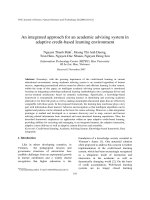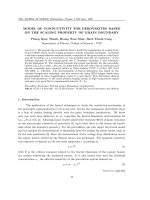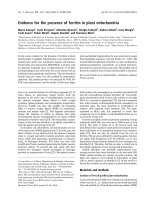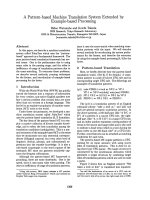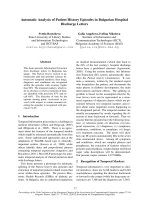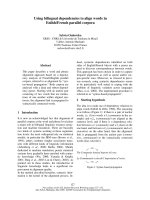Báo cáo " An integrated approach for an academic advising system in adaptive credit-based learning environment " ppt
Bạn đang xem bản rút gọn của tài liệu. Xem và tải ngay bản đầy đủ của tài liệu tại đây (830.75 KB, 12 trang )
VNU Journal of Science, Natural Sciences and Technology 24 (2008) 110-121
110
An integrated approach for an academic advising system in
adaptive credit-based learning environment
Nguyen Thanh Binh
*
, Hoang Thi Anh Duong,
Tran Hieu, Nguyen Duc Nhuan, Nguyen Hong Son
Information Technology Center (HITEC), Hue University
02 Le Loi, Hue, Vietnam
Received 5 November 2007
Abstract. Nowadays, with the growing importance of the credit-based learning in current
educational environment, strong academic advising system is an essential ingredient of learner
success, supporting personalized advices aimed at effective and efficient learning. In that context,
within the scope of this paper, an intelligent academic advising system approach is introduced
focusing on integrating technology-enhanced learning methodologies into a pedagogy-driven and
service-oriented architecture based on semantic technology. Specifically, a knowledge-based
framework is conceptually introduced, assisting learners in identifying and assessing academic
alternatives for their life goals as well as making meaningful educational plans that are effectively
compatible with those goals. In the proposed framework, the learning data warehouse plays a key
part with information about learners’ behavior and navigation so that intelligent algorithms can be
applied and patterns can be obtained as the basis for course advising. Moreover, a data integration
prototype is studied and developed as a resource discovery tool to map, convert and harvest
advising related information from structured and semi-structured learning repositories. Thus, the
described framework emphasizes its application within an open adaptive credit-based learning,
providing abilities for accessing and managing, in an integrated manner, the adaptive interaction,
adaptive course delivery as well as adaptive content discovery and assembly.
Keywords: Credit-based learning, Academic Advising System, Knowledge-based framework, Data
integration
1. Introduction
*
Like in others developing countries, in
Vietnam, the pedagogical mission and
governance structures of universities face
credible challenges from an exponential growth
in learner enrollment and a widely shared
recognition that higher education is the
*
Corresponding author. E-mail:
foundation of a knowledge society essential to
Vietnam’s future [1]. One potential solution
often proposed to address this concern is further
implementation of the credit-based learning
system, which has been increasingly recognized
as a ubiquitous mode of instruction and
interaction in the academic as well as
dynamically changing world [2]. On the basis
of credit accumulation, Web-based learning
systems are no longer closed learning
Nguyen Thanh Binh et al. / VNU Journal of Science, Natural Sciences and Technology 24 (2008) 110-121
111
environments where courses and learning
materials are fixed and the only dynamic aspect
is the organization of the material that can be
adapted to allow a relatively individualized
learning environment [3].
However, with the increase popularity of
online education, e-Learning systems have to
face critical challenges, such as the learners’
feeling of isolation and disorientation in the
course hyperspace as well as the difficulty in
addressing the needs of each individual learner.
To help promote learner mobility, learners have
to be supported in finding information, in
decision-making, in dealing with all the
formalities when filling in the application forms
[4].
In this context, Web academic advising
system for learners is gaining popularity in
recent times among Universities. The major
goal of academic advising is to help learners to
develop educational plans that are compatible
with the personal life goals. The importance of
advising lies in assisting the learner in
identification of personal initial, life goals and
frequently changes of direction. On the more
applied level, academic advising assists learners
in understanding the regulations and
requirements of a chosen program, and
selecting the most effective and efficient path
toward graduation [5].
Usually, Academic advising is an important
and time-consuming task and different
tools/techniques can be used to make it an
efficient process [5]. Most of the process,
however, relies on personal interactions
between learners and counselors, which lead to
problems such as poor utilization of resources.
Meanwhile, Learning Management Systems
(LMS) keep a vast amount of data collected
through the tracking of the learners’
interactions, such as time spent on course
pages, scores achieved in quizzes, postings to
discussion forums, etc. [6]. However, this
tracking data is rarely used by LMS to
automatically guide or advise the learners in
their course selection and scheduling.
In response to these problems, the main
contribution of this paper is to conceptually
introduce an integrated knowledge-based
framework based on service-oriented
architecture along with semantic technology,
implemented in the context of Hue University.
In the proposed framework, the learning data
warehouse plays a key part in collecting vast
amounts of learner profile data, i.e. learners’
behavior and navigation. On the basis of this,
data mining and knowledge discovery
techniques can be applied to obtain interesting
relationships between attributes of learners,
assessments, and the solution strategies adopted
by learners. Moreover, a data integration
prototype is studied and developed as a
resource discovery tool to map, convert and
harvest advising related information from
structured and semi-structured learning
repositories to the data warehouse. Taken
together and used within the online educational
setting, the value of the proposed approach lies
in semi-automatic assisting learners to identify
and assess academic alternatives for their life
goals as well as making meaningful educational
plans, improving learner performance and the
effective design of the online courses.
The rest of this writing is organized as
follows: section 2 introduces some approaches
related to our work; section 3 presents the Hue
University context, one of the biggest
universities for training, research, as well as
cultural, scientific and educational exchanges in
Central Vietnam; section 4 proposed framework
with its detailed specification and explanation
of core modules, hereafter, courseware structure
and metadata required to describe the course
material is then presented; and in section 4, a
Nguyen Thanh Binh et al. / VNU Journal of Science, Natural Sciences and Technology 24 (2008) 110-121
112
prototype of data integration based on Web
service is described. At last, section 5 gives a
summary of what have been achieved and
future works.
2. Related works
Since the introduction of management
information systems into university settings to
deal with and manage massive amounts of
information, attempts have been made to use
computers as advising tools. In this section, we
will review relevant work in the computer-
based advising in educational systems to
identify important issues that should be
considered in building a framework for
advising the learners in credit-based e-Learning
system.
As stated in previous section, Web
academic advising system for learners is
gaining popularity in recent times among
Universities, such as Indiana University, North
Carolina State University, West Washington
University, etc. [7] However, it seems that the
most of the international related work has been
done concerning about the career guidance
rather than focusing primarily to study
guidance, when universities, in the beginning of
the 21st century, “have seen a rapid growth in
guidance services”, but that “there is no
common trend” among these services [7].
Most of the pages entitled Web-based
advising are typically a bulletin board with
advising-related announcements; a repository of
official documents in PDF or HTML format; a
collection of useful links that help learners get
official advising-related information off the
Web; or a combination of those [4]. They
hardly include any scripts or Web server
programs to process specific learner
information and produce customized advice for
learners [4]. Over the years, there are
approaches in developing an electronic
academic counseling system primarily focusing
on educational planning and advising resources
in support of learner's academic objectives. E.g.
Marques et al [5] introduced a system that was
intended to make learners more proactive in
advising-related issues, integrating
conventional advisor advising and Web-based
advising to form a learner-centric advising
model to engage undergraduate learners
actively in their education process.
With enormous repositories of learning data
on the Web, there arises a potential trends of
applying knowledge discovery techniques in
web-based academic advising system, in which
Data mining techniques could be applied to
web-based distance learning in order to track
learner activities in a course web site to extract
patterns and behavior profiles that help learners
to improve their learning results [8, 9].
Meanwhile, based on data extracted from log
data in an education web-based system, Minaei-
Bidgoli and Punch [8, 10] use data related to
educational resources (e.g. web pages,
demonstrations, simulations, homework
assignments, quizzes) and user information,
data mining methods are analyzed for extracting
knowledge to identify types of learners.
Nonetheless, just knowing most frequent
patterns is not enough: it is of vital importance
to integrate this information into the system so
that this information is used proactively when a
learner is connected. An evolving e-learning
system is described in [7] which can adapt itself
to its users and to the open web based on the
usage of its learning materials. The system
users are clustered based on their learning
interests. Moreover, based on ontology and
agent technology, e-Advisor, an Intelligent
System that Facilitates Academic Advising and
Program Planning, is designed to help assist
learners in choosing their courses in a distance-
education based university setting.
Nguyen Thanh Binh et al. / VNU Journal of Science, Natural Sciences and Technology 24 (2008) 110-121
113
However, the existing approaches only
develop web-based academic advising system
with the advising logic is tightly coupled to the
system itself and without intelligence help.
Meanwhile, Academic advising and program
planning is a complex problem solving process
that involves intensive multi-participant
cooperation in an uncertain environment [11].
Therefore, effective computer-aided program
planning and advising hinges on the modeling
and representation of knowledge about the
domain knowledge, program structure and
regulations as well as learners. In our work, we
present a semantic-based academic advising
framework with a data warehouse architecture
is one of the core components, taking advantage
of tracking data supporting automatically guide
or advise learners, reducing their workload and
empower their learning. Moreover, information
related to courses, topics, and activities will be
integrated with navigation information prior to
the application of data mining algorithms in
order to obtain patterns. In this context, we
focused on semantic heterogeneity problems in
data integration, especially in the extraction,
transformation and loading (ETL) process [12],
which is one of the main objectives of this
paper.
3. Hue university context
Hue University is composed of 7 affiliated
colleges and variety of center such as Learning
Resource Center, Center for Distance Training,
and Center for Information Technology, located
in various areas of the city and incorporated in
90s to address the problems associated with
better managing and using the massive amounts
of information required in the growing areas of
higher education. All 7 of the colleges are
general-purpose institutes of higher learning
offering baccalaureate and graduate degrees in
the Natural Sciences, Social Sciences and
Humanities, Medicine, Agriculture & Forestry,
Economics, Fine Art, Foreign Languages as
well as other selected degrees.
As a step towards lifelong learning, Hue
University Information Technology Center has
developed the e-Learning Portal, making
learners more self-directed and responsible for
their own learning path, by means of advanced
learning technology to structure and organize
their lifelong learning process. Since June 2007,
this e-Learning Portal has been widely adopted
in member colleges of Hue University, offering
the opportunities to enhance the learning
environment of our learners as well as the
management and administration of programs
and module delivery and support.
In august 2008, Hue University will begin
the first semester adopting the credit-based
degree system defined in the credit-based
learning strategy of Ministry of Education, the
main goal of which is to improve the
competitiveness and attraction of Vietnamese
higher education. For higher education in the
Hue University, the major goal of credit-based
learning environment is to provide a
distinguished University System which will
support maximum educational opportunities for
the learners, without unnecessary duplication or
proliferation, through distinguished member
colleges that have separately designated
responsibilities and which will collectively
offer programs in all disciplines and professions
at all levels [6].
Nguyen Thanh Binh et al. / VNU Journal of Science, Natural Sciences and Technology 24 (2008) 110-121
114
The new context on University degree
emphasizes that the universities should pay
extra attention to the quality assurance. Many
standards and guidelines for quality assurance
in the Higher Education area have been defined
within higher education Universities. One
subcategory in that area is the learning
resources and learner support which are defined
that universities should ensure the resources
available for the support of learner learning are
adequate and appropriate for each offered
program; again bring attention to the need to
enhance the quality of academic advising and to
improve the management of the curriculum.
In practice, it has been stated that every
learner will create or be created a personal
study plan for his studies in the beginning of his
academic career. The university provides the
requirements of the Bachelor or Master degree
which must be fulfilled by the learner in effort
to be graduated. On the other hand, the
university offers set of courses in every period.
In this context, the counseling must include
instructing the learner on how to best benefit
from the given tool and counseling itself [11].
The personal study plan helps learner to
schedule studies for his forthcoming year and it
also stands as a tool for monitoring the progress
of studies both for the learner and the
universities.
By sharing a commonality in program
offerings and common course numbering in
these areas, the transferability of coursework
among Hue Colleges can better meets the
emergent needs for the single, system-wide
advisement system. A common prefix and
course number assigned to similar courses
within the University allows for articulation
across colleges in the advising system without
the need for manual input to the Learner
Academic Advising System.
4. Knowledge-based academic advising
system framework in adaptive credit-based
learning environment
This section proposes a framework based on
semantic technology and describes its main
mechanisms, allowing users to generate semi-
automatic computer-based advising in e-
Learning systems using Decision Support
techniques such as Data warehouse and Data
mining. The system is currently in development
and includes the essential functionality required
of an academic advising system. In particular,
the proposed framework capable of integrating
learner information, including academic
Nguyen Thanh Binh et al. / VNU Journal of Science, Natural Sciences and Technology 24 (2008) 110-121
115
program and course history, and making a
reasonable recommendation of courses learners
could enroll.
The key feature of our approach in
developing tracking data is to use terminology
concepts as both a medium of domain
knowledge representation and a navigable
structure, establishing the semantic foundation
for the framework. Moreover, in order to be
interoperable, these information resources must
comply with technological standardization, in
addition to knowledge standardization
(consensus on the meaning of educational
content) [13]. In our framework, integrated
information resources are represented using
standard formalisms, including standards, such
as Dublin Core as well as XML and its
corresponding recommendations. Knowledge-
based Academic advising system architecture
with core components is represented in the
Figure 1.
Fig. 1. Academic Advising Framework and its main components.
With learning offers from universities or
colleges, which are highly structured, leading to
a specific accreditation and have domain
experts that guarantee quality like in
universities, terminology or metadata
recommendation techniques will be the most
suitable. Curriculum offered by an educational
institution is essentially a catalogue containing
all courses offered along with their descriptions.
Each course is described by a set of attributes,
such as the period of the year (term) it is offered
in, the set of courses it is a prerequisite for, the
set of atomic skills it leads to, etc. This domain
knowledge provides controlled learning
vocabularies with certain metadata elements,
e.g. subject and keywords: content description
can be visible in the terms such as “Learning
object”, “Module”, “Lesson”, etc. Other
concepts like “Introduction”, “Explanation” and
“Example” are used to describe contexts for the
learning content. The most important part of the
structure model is terms describe relations
between learning content such as
“has_Component”, “partofLesson”, etc. All this
metadata could be used to recommend courses
to learners.
The conceptual model is specified in OWL
resembling an simple ontology specification, i.e.
defines classes, individuals, and properties, and
uses OWL properties to define relationships. It
makes links to resources defined in the domain
knowledge. The proposed framework uses
Nguyen Thanh Binh et al. / VNU Journal of Science, Natural Sciences and Technology 24 (2008) 110-121
116
Protégé OWL extensively for input and output of
OWL ontologies and models, creating and
changing OWL resources and resolving domain
ontology queries. We also use the generic
reasoner from Protégé to make inferences from
the domain ontology.
Using Protégé OWL, the domain
knowledge described above is represented
through classes as well as properties,
constraints and rules on identified classes. With
the ability of loading and saving OWL files in
various formats, the framework can take
advantage of the declarative formal
representations of well-defined semantic
background by means of metadata repository.
The more business related information we
gather the more profit we can make out of it,
and consequently, the most intelligent
recommendation will be made [9]. In this
approach, the proposed framework is based on a
comprehensive web data warehouse integrating
information that have to be stored, e.g.
Information gathered by the operational
systems of interest for users profiling:
information related to students (requirements,
preferences, and behaviors), enrollment, exams
and qualifications; Navigational information:
all the information related to users navigations
gathered by web server: (sessions, time of stay
in courses ). During an extensive ETL
(extract, transform, and load) process [14]
according to the data semantics, the specified
data is added to the warehouse from distributed
data sources.
In this context, one of the most important
components in the framework is the data
integration tool proposed to handle the design,
integration, and maintenance of heterogeneous
schemas of learning information resources,
including tracking data of learners, courses, etc.
It serves for describing each local schema and
the mapping rules between a local schema and
the global schema. In this component, the well-
defined terminology will provide a systematic
and semantic way to map different terms to find
the specific information interested.
By the means of the data integration tool,
our approach is also aimed to provide abilities
for interoperability searching and metadata
integration among learning information
resources, provides rich information about
learners and can be used to automatically
generate build learner models. These models
should hold knowledge required to generate
appropriate advice to learners. The most
important role of this component is to integrate
data from different data sources with two
methods to connect to data source: connect to
data source via Web Service and connect
directly to data source. The result of the
integration process is saved in the form of
XML-based file with Dublin core standard.
For largely autonomous organizations such
as e-Learning, the amount of data is so great
that manual analysis of the data in timely
manner is difficult, if not impossible. The need
to handle such large volumes of data led to the
demand that data repository must be readily
available and easily accessible. In our approach,
the integrated data will then be loaded into a
data warehouse with twofold structure: on the
one hand, it has to store information so that data
mining algorithms can be applied and patterns
are obtained [9]; on the other hand, such an
structure has to be the repository of patterns
applied to data so it stores information about
learners’ behaviors and navigation patterns.
This data warehouse, supporting the
consolidation of atomic level data from
multiple data sources in a structured way and
enabling timely, accurate recommendation.
Given the multidimensional structure of
defined data warehouse, the knowledge-based
framework supports the off-line module
(mining tool) and the on-line module (advising
engine). The proposed framework can also
Nguyen Thanh Binh et al. / VNU Journal of Science, Natural Sciences and Technology 24 (2008) 110-121
117
support frequent item sets, depicting the
knowledge that obtained from navigational
activity of other users who act commonly with
the current user. Using the knowledge of the
domain, the Advice Generator can compute the
potential recommendation set, i.e. retrieve a list
of the most relevant courses found in the domain
terminology for the given inquiry. Specifically,
the Advice Generator will investigate and
analyze the constructed learner models and
generate appropriate advice to learners.
On the basis of learner patterns discovered
from the data warehouse and taking advantage
of the domain knowledge, the proposed
approach focuses only on those sets that come
from the combination of the domain
knowledge’s recommendations and the current
user. Thus, the framework can reduce the time
spend on parsing all frequent item sets and
association rules, resulting in a smaller
searching space.
Hereafter, the system will rank the courses
according to the perceived relevance to the
learner. This initial list represents the proposed
recommendation. Then the Advice Generator
can acts as a filter for the proposed solution by
removing any course that the learner is not able
to enroll in the next semester, in the
circumstance that courses for which the learner
does not satisfy the prerequisites. Also based on
the domain knowledge, the filter next removes
courses that are not relevant to satisfying the
learner’s academic program requirements. For
example, if either of two essentially identical
courses satisfies a requirement and the learner
has already completed one, the filter removes
the other course from the proposed solution.
Finally, the filter will use characteristics
provided by the learner to present a ranking of
course recommendations. With the list of
highest ranked recommendations, the learner
may filter the list manually, removing courses
that are not appropriate.
Fig. 2. Business model of the Data integration Module.
Nguyen Thanh Binh et al. / VNU Journal of Science, Natural Sciences and Technology 24 (2008) 110-121
118
Moreover, based on dimensional
hierarchies, the system can support OLAP-like
aggregation capabilities, thus provides more
complex recommendations that deal not only
with individual criteria, but also with groups of
criteria. For example, we may want to know not
only how individual users like individual
courses but also how they may like categories
of courses.
Since the learning history data sources are
of interest in the architecture, one of the very
first modules that we have implemented is the
data integration tool, establishing the correct
relationships between the local schema and the
data warehouse. In that context, in the process
of integration, the Data Integration tool allow
data provider to save the maps of data source.
Based on mapping information in XML-based
files, the data from various sources can be re-
classified and re-interpreted as well as
integrated using terminology concepts.
Fig. 3. Data Integration Tool Architecture supporting Academic Advising System.
5. Preliminary results – a data integration
prototype based on Web service
Extracting data from heterogeneous data
sources and transferring data into the data
warehouse system is one of the most cost
intensive tasks in setting up and operating a
data warehouse [12]. Especially, in academic
advising system, building the Data Integration
tool, which enhances access to and provision of
high quality learning history-related
information, is a very challenging task because
it can often involve many educational
organizations with various platforms and
databases. In this context, to evaluate the Data
Integration tool model, we implemented a Data
Integration prototype that manages and
integrates semantic metadata. The bottom layer
of the architecture consists of autonomous data
sources that may be structured or semi-
structured. The current prototype supports the
Nguyen Thanh Binh et al. / VNU Journal of Science, Natural Sciences and Technology 24 (2008) 110-121
119
mapping of relational databases and XML
documents. The design and implementation
following proposed approach are presented in
this section.
The implemented prototype may be used to
connect different sources and target systems,
enabling the flexible integration of data sources
into target system (i.e. the data warehouse). The
approach is based on the idea of establishing
the communication between these data sources
and target based on the use of Web Service
technology [15] to describe and dynamically
integrate participating data sources and the
deployment within a specific database system.
In this paper, we focus on the integration of
heterogeneous schemas of heterogeneous
learning information systems. In this approach,
we are going to use predefined XML tags as
proposed by the Dublin Core, XML Standard.
Therefore it will be possible to use tools based
on the XML standard to create, generate, and
maintain such XML descriptions easily.
Hereafter, the ETL process of data
integration into the data warehouse is illustrated
by details of our case study: how the mapping
task has been performed, which methodology
has been applied, followed by some typical
screenshots of different mapping steps in
implemented prototype.
5.1. Defining a new data provisioning source
In this step, the administrator will create
information of the new data provider, account
information as well as the e-Learning platform
which is currently adopted along with the
database in use. If the data provisioning source
is provided by means of web services, then this
information will also be defined.
Fig. 4. Defining a new data provisioning source.
5.2. Identifying data provisioning service
This step will define information about the
data provisioning service used by sources.
Based on this, system will connect to the
service, thus obtain information about specific
service activities, by means of the two lists of
data provisioning functions.
Fig. 5. Identifying Data Provisioning Service.
The specified information will then be used
to establish the connection to the data source in
the next step.
Nguyen Thanh Binh et al. / VNU Journal of Science, Natural Sciences and Technology 24 (2008) 110-121
120
Fig. 6. List of data provisioning sources.
5.3. Mapping
Based on the elements selected in above steps,
a schema can be specified to represent the
relationship among them, thus a mapping from this
schema to the standard schema will be defined.
Fig. 7. Mapping from this schema to the standard
schema.
5.4. Integration
In this step, the integration request will be
delivered to the selected data provisioning
source at a predefined time and the data will be
harvested and converted to data warehouse
standard, completing the data integration
process (the ETL process).
Fig. 8. Data extraction from a data provisioning
source.
Fig. 9. Transform and load data to the standard data
warehouse.
Fig. 10. Log file of the ETL process.
6. Conclusion
In the context of emerging credit-based
learning environment, it is our belief that to be
a better help to learners, an academic advising
system should implement in much greater
measure at least the information giving, short-
range program planning, student evaluation,
and explanation of actions goals, as well as be
capable of generating an optimized schedule
[7]. Adding more flexibility in schedule
adjustments, substitution of courses, and more
sensitivity to student preferences and
constraints would make it possible to cope with
different categories of students [11].
Consequently, in this paper we have
presented the design of a knowledge-based
academic advising framework, adding
intelligence to e-learning supporting tools,
supporting the ability to understand and profit
from learning history data. In the proposed
framework, a learning data warehouse gathers
and stores information coming from operation
and navigational systems for future analysis by
means of data mining techniques. A prototype
of the presented Data Integration tool, one of
Nguyen Thanh Binh et al. / VNU Journal of Science, Natural Sciences and Technology 24 (2008) 110-121
121
the most crucial components in the architecture,
has been already implemented and tested at Hue
University and results are very promising.
Thus, the proposed approach creates a context
in which learners can better understand the
nature of the learning environment and more
fully appreciate the importance of developing
the skills, attitudes, and work habits that they
will need to become truly independent citizens.
Our next steps include the extension of the
system with semantic search capability and
inference engine, as well as the adaptation of
the conceptual framework presented here to
establish well-known discovery processes real
life academic advising system. Moreover,
further research lies in the area of expanding the
system with semantic attributes, such as adding
semantic annotation to the Web services
exported, in order to enable it with broader
integration capabilities with other ontology
based resources systems.
References
[1] E. Mazur, P.T. Ly, “The American Credit System’s
Pedagogical Objectives: Implications for Vietnam’s
Higher Education Reform,” Available :
[2] The Quality Assurance Agency for Higher Education
2006, Academic Credit in Higher Education in
England, ISBN 1 84482 638 4.
[3] R. Farzan, “Adaptive Socio-Recommender System
for Open-Corpus E-Learning,” in Doctoral
Consortium of the Third International Conference on
Adaptive Hypermedia and Adaptive Web-based
Systems (AH'2004), Eindhoven, the Netherlands.
[4] S. Hsu, O. Marques, M. Ilyas, X. Ding, "Web-Based
Undergraduate Academic Advising System", in Proc.
International Conference on Engineering Education
2002, August 18 - 22, 2002, Manchester, UK.
[5] O. Marques, X. Ding, S. Hsu, "Design and
Development of a Web-based System for Academic
Advising", in Proc. 2001 ASEE/IEEE Frontiers in
Education Conference (FIE '2001), October 10-13,
2001, Reno, Nevada.
[6] H.Y. Hill, A case study of the student academic
support system: state university system of florida,
Fall term, 2004.
[7] T.Y. Tang, G. McCalla. “Smart Recommendation for
an Evolving E-Learning System: Architecture and
Experiment”, in Journal of E-Learning, AACE
Publishers 4(1) (2005) 105.
[8] B.Minaei-Bidgoli, “Data mining for a web-based
educational system,” Dissertation, Department of
Computer Science and Engineering, Michigan State
University, 2004.
[9] C. Romero, S. Ventura, J.A. Delgado, P. De Bra,
“Personalized Links Recommendation Based on
Data Mining In Adaptive Educational Hypermedia
Systems,” in Proc. Second European Conference on
Technology Enhanced Learning (EC-TEL 2007),
Springer LNCS, ISBN 978-3-540-75194-6, 292-306.
2007.
[10] B. Minae-Bigdoli, W.F. Punch HI, “Using genetic
algorithm for data mining optimzation in an
educational web-based system,” in Proc. WWW 2004,
May 17-22, New York, (2004) 675.
[11] H. Drachsler, H.G.K. Hummel, B. Van den Berg, J.
Eshuis, A.J. Berlanga, R.J. Nadolski, W. Waterink,
N. Boers, R. Koper, “Recommendation strategies for
e-learning: preliminary effects of personal
recommender system for lifelong learners,”
Submitted, Maastricht 2007.
[12] R. Kimball, J. Caserta, The Data Warehouse ETL
Toolkit, Wiley Publishing, Inc. 2004.
[13] N.T. Binh, T. Hieu, H.T. Anh Duong, “An ontology-
based tool for integrating learning heterogeneous
information resources,” in Proc. National Symposium
on Research, Development and Application of
Information and Communication Technology
(ICT.rda), Hanoi, Vietnam (2006) 247.
[14] R. Kimball, M. Ross, The Data Warehouse Toolkit.
John Wiley & Sons, Inc. 2002.
[15] T. Erl, Service-Oriented Architecture: Concepts,
Technology, and Design, Prentice Hall, 2005.


